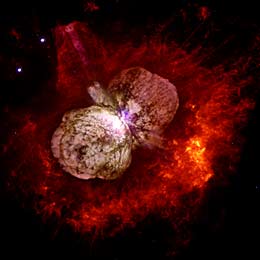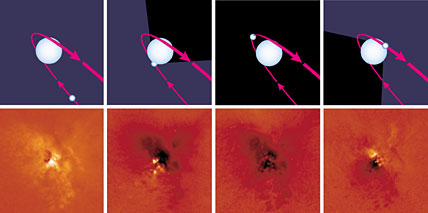
This Hubble Space Telescope image shows the hourglass-shaped Homunculus Nebula that surrounds the supermassive star Eta Carinae. In the 1840s, Eta Carinae suffered a violent eruption that ejected the Homunculus. The star is surrounded by so much material that we cannot see its surface, even though it shines with the energy of 5 million Suns. It lies 7,500 light-years from Earth.
Courtesy Nathan Smith and NASA.
Lately things just don’t seem the same with Eta Carinae, one of our galaxy’s most amazing stars. The blue supergiant weighs in with at least 100 solar masses, and it pumps out as much energy in 6 seconds as the Sun does in an entire year. During the 1840s the star brightened tenfold as it explosively ejected an astonishing 5 to 15 solar masses of material to form the surrounding Homunculus Nebula. Eta Carinae somehow managed to survive this catastrophe, whose cause remains a mystery.
But incredible luminosity and giant eruptions are just part of the story. Recent changes in a "purple haze" surrounding Eta Carinae offer virtual proof that this supergiant is even more impressive than originally thought. It isn’t just one massive star, it’s two.
Many astronomers have suspected that Eta Carinae is a binary since 1996. In that year, Augusto Damineli (University of São Paulo, Brazil) pointed out that every 5.5 years Eta Carinae’s spectrum exhibits sudden and short-lived changes. According to Damineli, a companion star in an elliptical orbit periodically swings close to the primary star, and the two stars’ colliding winds temporarily alter the system’s behavior. Damineli’s idea was bolstered in late 1997 and early 1998, when the predicted spectral changes occurred right on schedule. But not all astronomers were convinced.
Even these dissenting voices will have a difficult time explaining the latest data with a single-star model. During the most recent event, which occurred in late June and early July 2003, astronomers observed Eta Carinae with instruments spanning almost the entire electromagnetic spectrum. Once again, Eta Carinae displayed the periodic changes expected in the binary model. In addition, ultraviolet observations with the Hubble Space Telescope’s Advanced Camera for Surveys (ACS) revealed subtle shadow and brightening effects as the companion star apparently swung around the primary.
Normally, the companion’s ultraviolet light heats and ionizes gas in the surrounding nebula, forming an excess of violet and ultraviolet light a few arcseconds from the primary star. ACS team leader Nathan Smith (University of Colorado) calls this glow "purple haze," after Jimi Hendrix’s rock anthem. Smith and his colleagues predicted that as the companion swung around the primary in mid 2003, it would approach so close (about three times the average Earth-Sun distance) that its ultraviolet light would be extinguished by the primary’s thick stellar wind in certain directions, casting shadows. In directions where ultraviolet light could escape the wind, it would produce bright spots in the purple haze.

The top panels show the positions of the primary (larger) star and a proposed companion swinging around it in an elongated 5.5-year orbit. The dark areas represent shadows cast by the primary’s intense stellar wind, which snuffs out the companion’s ultraviolet light. The bottom panels show ultraviolet images of Eta Carinae taken by Hubble’s Advanced Camera for Surveys in mid to late 2003. They show bright and dark spots in the surrounding 'purple haze' that changed position from month to month. Note how the dark spots match up closely with the shadowed regions in the corresponding top panels.
Top panels: S&T illustrations by Steven A. Simpson; source: Nathan Smith. Bottom panels: Courtesy Nathan Smith and NASA.
This effect is exactly what Smith and his colleagues observed with ACS. After accounting for light-travel time, Smith’s team noticed ultraviolet shadows and bright spots in the purple haze that changed position over several months, just as one would expect if a companion star approached the primary on one side, and then quickly swung around to the opposite side about a month later.
"The star would have to eject material in one direction first, and then in the exact opposite direction right after that, to account for our observations," says Smith. "This would be highly unusual, even for Eta Carinae."
These observations leave little doubt that Eta Carinae is a binary, probably consisting of a 100- to 150-solar-mass primary and a 30- to 60-solar-mass companion. In Smith’s model, which is consistent with a variety of data, the companion follows a highly elongated orbit like a cigar that is nearly perpendicular to Earth’s line of sight. "Eta Carinae does all sorts of bizarre things. Now we need to sort out what is caused by the binary and what is not," says Smith, whose paper has been accepted for publication in an upcoming issue of the Astrophysical Journal Letters.
Unfortunately, the likely decommissioning of Hubble is bad news for the astronomers who study Eta Carinae. No telescopes are being planned that would have sufficient ultraviolet capability and high resolution to see these shadows and bright spots, which is just one of many losses that would follow Hubble’s demise.
 0
0
Comments
You must be logged in to post a comment.